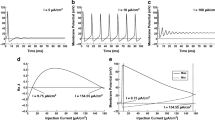Abstract
The behavior of two pacemaker neurons simulated by leaky integrators and connected reciprocally by synapses was studied. In every case the firing of both neurons phase-locks. The resulting limit cycle may or may not show simultaneous firing of both neurons. When both synapses are excitatory, phase-locking with simultaneous neuronal firing is always present. When one synapse is excitatory and the other inhibitory, phase-locking is also present always, while the neurons may or may not fire simultaneously. For a restricted set of parameters, bistability appears; the initial conditions determine whether or not the limit cycle presents simultaneous firing. When both synapses are inhibitory, the system phase-locks without simultaneous firing for almost every set of parameters.
Similar content being viewed by others
References
Allen T (1983) On the arithmetic of phase-locking: coupled neurons as a lattice on R2. Physica 6D:305–320
Angelini F, Petracci D (1978) Significance of phase-locking measurements as a test for neural encoding models. Biol Cybern 30:169–177
Arnold V (1980) Chapitres supplémentaires de la théorie des equations différentielles ordinaires. Mir, Moscow
Budelli R, Soto E, González-Estrada M, Macadar O (1984) A spike generator mechanism model simulates utricular responses to sinusoidal vibrations. Biol Cybern 54:237–244
Budelli R, Torres J, Catsigeras E, Enricht H (1991) Two neurons network. I. Integrate and fire pacemaker models. Biol Cybern 66:95–110
Castigeras E, Budelli R (1992) Limit cycles of a bineuronal network model. Physica D 56:235–252
Cervantes A (1989) Modulación de la descarga repetitiva ante pulsos externos en neuronas del caracol Helix aspersa. Master Thesis, Univesidad Autónoma de Puebla, Mexico
Glass L, Mackey MC (1988) From clocks to chaos. Princeton University Press, Princeton
Glass L, Pérez R (1982) Fine structure of phase-locking. Phys Rev Lett 48:1772–1775
Glass L, Guevara M, Shier A, Pérez R (1983) Bifurcation and chaos in a periodically stimulated cardiac oscillator. Physica 7D:89–103
Hardy G, Wright E (1979) An introduction to the theory of numbers. Clarendon Press, Oxford
Hartline DK, Gassie DV (1982) Artificially cross-cupled tonic neurons Prodūce alternating bursts. Soc Neurosci Abstr 8:739
Heiligenberg WF (1991) Neural nets in electric fish. MIT Press, Cambridge, Mass.
Katz AM (1992) Physiology of the heart. Raven, New York
Keener JP (1980) Chaotic behavior in piecewise continuous difference equations. Trans Am Math Soc 261:589–604
Kirillov AB, Myre CD, Woodward DJ (1993) Bistability, switches and working memory in a two-neuron inhibitory-feedback model. Biol Cybern 68:441–449
Knight B (1972) Dynamics of encoding in a population of neurons J Gen Physiol 58:734–766
Mirollo RE, Strogatz SH (1990) Synchronization of pulse-coupled biological oscillators. SIAM J Appl Math 50:1645–1662
Mulloney B, Perkel D, Budelli R (1981) Motor-pattern production: interaction of chemical and electrical synapses. Brain Res 229:25–33
Pérez R, Glass L (1982) Bistability, period doubling bifurcations and chaos in a periodic forced oscillator. Phys Lett 90A:441–443
Perez R, Lomnitz-Adler J (1988) Coupled relaxation oscillators and circle maps. Physica 30D:61–82
Perkel DH, Mulloney B (1974) Motor pattern production in reciprocally inhibitory neurons exhibiting postsynaptic rebound. Science 145:61–63
Peskin CS (1975) Mathematical aspects of heart physiology Courant Institute of Mathematical Sciences, New York
Rescigno A, Stein R, Purple R, Poppele R (1970) A neuronal model for the discharge patterns produced by cyclic inputs. Bull Math Biophys 32:337–353
Selverston A, Moulins M (1985) Oscillatory neural networks. Ann Rev Physiol 47:29–48
Stein R, French A, Holden A (1972) The frequency response, coherence and information capacity of two neuronal models. Biophys J 12:295–322
Author information
Authors and Affiliations
Rights and permissions
About this article
Cite this article
Gómez, L., Budelli, R. Two-neuron networks. Biol. Cybern. 74, 131–137 (1996). https://doi.org/10.1007/BF00204201
Received:
Accepted:
Issue Date:
DOI: https://doi.org/10.1007/BF00204201




